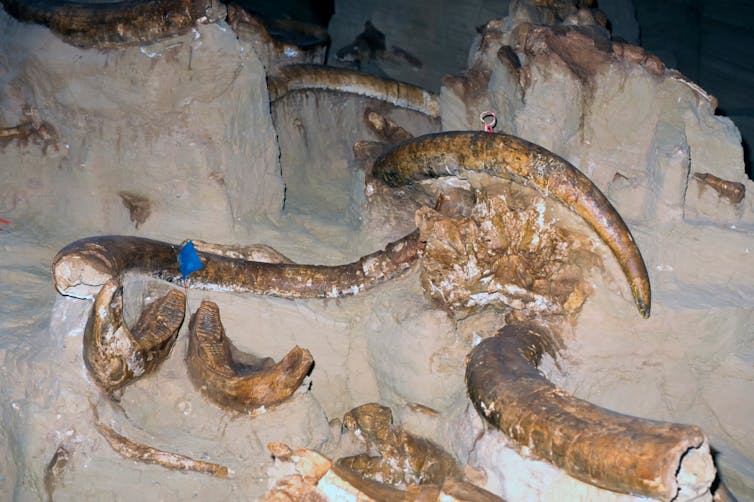In recent years, the global trade in elephant ivory has faced significant restrictions in an effort to protect dwindling elephant populations. Many countries have stringent controls on the trade of elephant ivory. The sale of mammoth ivory, sourced primarily from long-extinct species, however, remains unregulated.
But it’s a significant challenge for customs and law enforcement agencies to distinguish between ivory from extinct mammoths and living elephants. This is a process that is both time-consuming and requires destroying the ivory.
Now our new study, published in PLOS ONE, presents a major breakthrough – using a well known laser technique to tell mammoth and elephant ivory apart.
Our results couldn’t come soon enough. The number of African elephants has dramatically declined from approximately 12 million a century ago to about 400,000 today.
Annually, over 20,000 elephants are poached for ivory, primarily in Africa. This decline not only disrupts ecological balance, but also diminishes biodiversity. Ultimately, it highlights the urgent need for conservation efforts to protect these species.
The hunt for mammoth ivory is also a problem. The new regulations are leading to a rise in the modern-day “mammoth hunter”. These are people who deliberately set out to excavate mammoth remains from the Siberian permafrost in the summer months.
Driven by the lucrative market for mammoth ivory, these hunters undertake expeditions in remote Arctic regions, where permafrost melting is accelerated by climate change. This has made previously inaccessible mammoth tusks more reachable.

This activity not only has commercial implications. It also raises significant ethical and environmental concerns. That’s because it disturbs preserved ecosystems and involves the extraction of resources that have great value to paleontological science.
Laser insights
Our study from the University of Bristol, in collaboration with Lancaster University and the Natural History Museum, introduces a potential game-changer. We use a non-invasive laser technique known as Raman spectroscopy to identify the origin of a piece of ivory.
The method works by analysing the biochemical makeup of the ivory, which consists primarily of mineralised tissue composed of collagen (the flexible organic component) and hydroxyapatite (a hard inorganic mineral, containing calcium).
Raman spectroscopy is a well established technique. It has previously demonstrated applications that range from identifying whisky, studying archeological human bones from the Mary Rose ship, understanding how turkey tendons develop and to even identifying the purity of meat sold by the food industry.
The technique works by directing a laser light onto the ivory sample. The energy from the light is temporarily absorbed by the bonds between molecules in the sample, and then almost instantly re-released. This released light scatters back with more or less energy than the initial laser light sent to the sample.
This carries information about the molecular vibrations within the material – providing a unique pattern of light for each type of ivory. The analysis involves studying the differences between these unique fingerprints.
Our study analysed elephant and mammoth samples provided by the Natural History Museum, London. It demonstrated that not only could the technique distinguish between mammoth and elephant ivory, it could also spot differences in ivory from living elephant species.
In fact, we successfully differentiated between ivory from the extinct woolly mammoth (Mammuthus primigenius) and two species of elephants still walking the Earth today (Loxodonta and Elephas maximus).
Important implications
This method offers several advantages over traditional techniques for ivory analysis. Raman spectroscopy is non-destructive and can be performed quickly. This makes it an ideal tool for customs officials who need to make rapid decisions. Our study was conducted on a benchtop spectrometer (a device which breaks up light by wavelength) within a laboratory. But research suggests cheaper and portable, handheld Raman spectrometers could offer equivalent results.
Further research will be needed to refine the technique and expand the database of ivory signatures. We are working with Worldwide Wildlife Hong Kong and the Foreign and Commonwealth Development Office to develop this technique.
More data will ultimately enhance the accuracy of species identification. It could potentially help us detect even finer distinctions – such as the age of the ivory or specific environmental conditions where the elephants or mammoths lived.
There are also other non-destructive techniques, such as X-Ray fluorescence spectroscopy, which could be used as a complementary method to identify the geographical region from which the ivory was taken.
As this technique becomes more accessible and widely adopted, it may become key in global conservation efforts, helping to prevent the illegal trade of elephant ivory.
This article was written by Dr Rebecca Shepherd, Senior Lecturer in Anatomy, University of Bristol. This article is republished from The Conversation under a Creative Commons license. Read the original article.


